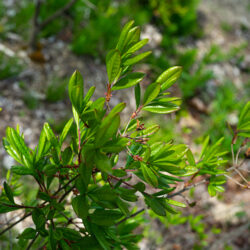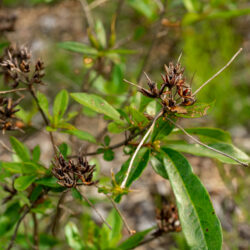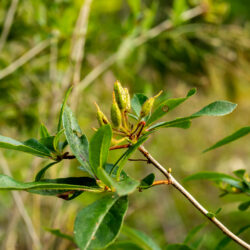Etymology
Rhododendron is Greek for rose-tree; viscosum is Latin for sticky, due to the stickiness of the flower petals.
Native Habitat
Swamps, bogs, stream margins and wet lowlands. It is at the northern limit of its range in southern and coastal Maine.
Garden Uses
Perfect for shrub borders, pond edges or wet areas, and open, dappled woodland gardens. It tolerates flooding, but not long-term standing water; moist, but draining areas are optimal. Foliage may scorch in full sun. May benefit from mulching to maintain moisture as it is shallow-rooted. Planted in groups with other azaleas or spring-blooming shrubs, it extends the bloom-season. Also holds well in bouquets. Can slowly naturalize via suckers.
Overview
This lovely native deciduous azalea grows best in moist loam and dappled sun. It grows from Maine to Florida and into the southern Appalachians, preferring acidic (pH < 6.8) soil. It blooms later in spring than most azaleas. Typically under 5 feet in height, it can grow up to 12 - 15 feet, and reach 12 feet in width. Azaleas are generally susceptible to various diseases (e.g. crown rot, powdery mildew, leaf spot) and insects (e.g. borers, aphids, scale, azalea sawfly), but healthy shrubs, well-placed, are considered easy to grow. There are 17 native North American azaleas; similar, but usually more southern, species include R. arborescens, which is hairless and has red stamen, and the dwarf R. atlanicum.
Leaves and Stems
Branches of this shrub are dark brown to gray, loosely upright and spreading. Branchlets are hairy. Bark is generally smooth, but in older plants, may be ridged or plated. Winter buds have overlapping scales. Leaves are simple, leathery, smooth, alternate, oblong, pointed, 1-1/2 to 3-1/2 inches long and 5/8 to 1-1/2 inches wide, and tend to cluster at the ends of branches. They are lustrous green, dark above and lighter on the underside, and attached by short stems (petioles). Fall foliage is orange to maroon.
Flowers
White to pale pink, trumpet-like, fragrant flowers grow in clusters of 4 to 9 at branch tips after leaves appear in June to July. They have 5 petal-like spreading, sticky lobes, 5 extended white stamen, a basal ovary, and a long, slightly lavender tube. Overall size of individual blossoms are 1-1/4 to 1-3/4 inches.
Fruit/Seed
Brown seeds mature in egg-shaped capsules up to 3/4 inches long. Seeds can be collected in fall and through the winter.
Animal Associates
Rhododendron contain substances poisonous to humans and other animals, and should not be ingested. Flowers are attractive to bees and humming birds.
Propagation
Seeds require no pre-treatment. Mix into sphagnum moss and grow on a 2:1 perlite and peat mixture under mist or a plastic tent at 45 - 50 degrees F. May also be propagated by tip-cuttings obtained post-bloom.
Ethnobotanical Uses
None found.
Garden Location
Library Garden (see garden map)
Anecdotal Information
Swamp azaleas in the library garden can be defoliated by azalea sawfly larvae (Amauronematus azalea). The larvae feed on the leaf edges, they are exactly the same color as the leaves and eat everything but the midvein. They can be controlled by hand picking. Plants typically leaf out again after defoliation.
Sources
Lady Bird Johnson Wildflower Center
Plant Profile by Kate O'Dell



